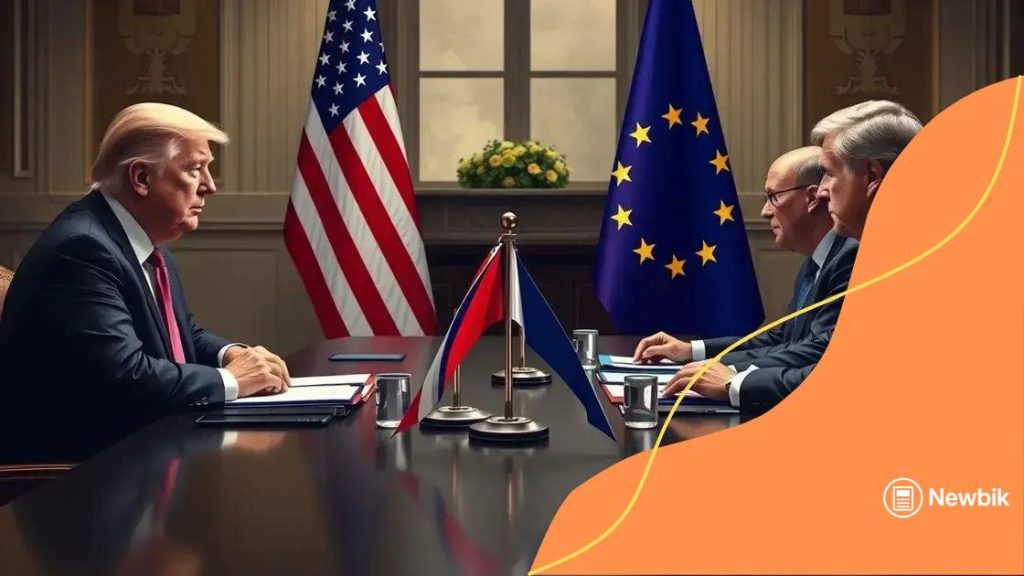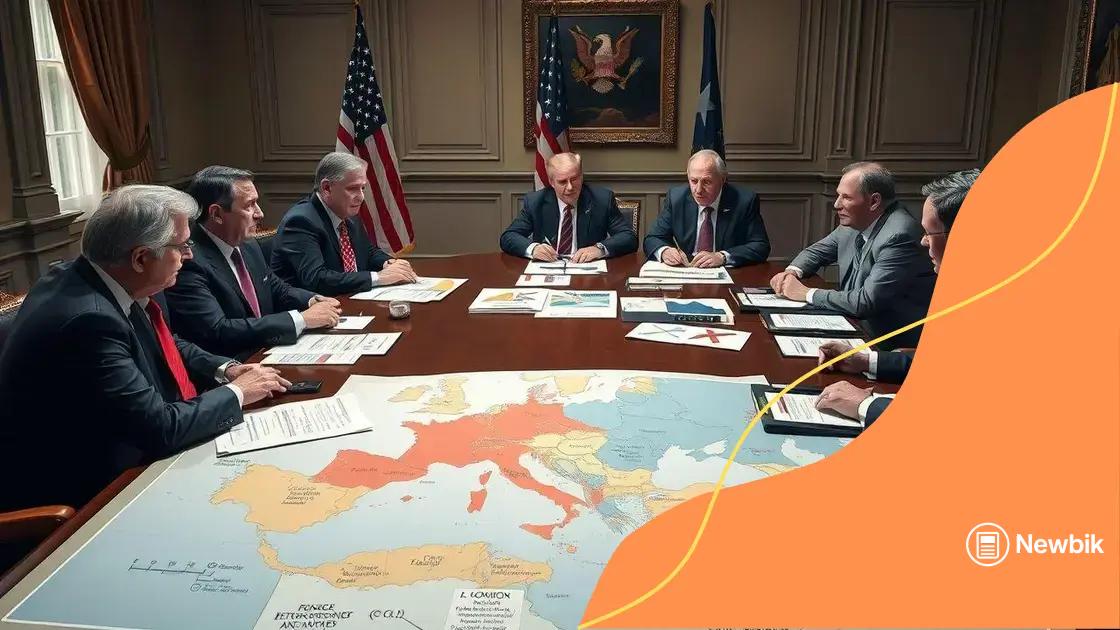US-Europe relations 2025: What to Expect Next

US-Europe relations in 2025 will focus on technological collaboration, climate action, and trade partnerships, while navigating political challenges and fostering cultural exchanges for mutual understanding.
US-Europe relations 2025 are on the brink of reshaping the global landscape. Have you ever wondered how evolving economics and politics might affect this pivotal relationship? Let’s dive into what lies ahead.
Historical context of US-Europe relations
Understanding the historical context of US-Europe relations is crucial to grasping their future dynamics. This relationship has evolved through significant events, including wars, treaties, and cultural exchanges.
Key Historical Events
Early interactions between the United States and European nations set the foundation for long-term partnerships. The Revolutionary War and subsequent treaties demonstrated mutual interests.
- American independence influenced European revolutions.
- World War I and II created bonds based on mutual defense.
- The establishment of NATO enhanced military cooperation.
As decades passed, economic ties grew stronger with mutual benefits. The Marshall Plan post-World War II laid the groundwork for economic recovery in Europe while fostering a strong alliance with the US.
Shifts in Partnership
Throughout the Cold War, the relationship was defined by a shared goal of containing communism. Europe relied heavily on the US for security and economic support. This period saw remarkable cooperation between the regions, leading to peace and stability.
In recent years, however, US-Europe relations faced challenges, including trade disputes and differing foreign policies. Understanding these historical patterns helps us anticipate future interaction.
Impact of economic shifts on partnerships
The impact of economic shifts on partnerships between the US and Europe is significant. As global economies evolve, so do the relationships between countries. Changes in trade policies, market demands, and financial stability can shape these vital partnerships.
Key Economic Factors
Economic conditions drive the priorities of nations. As one economy grows, it can lead to increased trade opportunities, while downturns can cause tensions. The changing landscape of technology also influences these partnerships.
- Fluctuations in currency values can affect trade balances.
- Economic growth in emerging markets generates new opportunities.
- Global supply chain issues can strain existing partnerships.
Over the years, different economic strategies have either strengthened or challenged US-Europe relations. For instance, the introduction of tariffs can disrupt established trade agreements. These disruptions force countries to adapt and negotiate new terms to maintain economic flow.
Recent Developments
In recent years, events such as the COVID-19 pandemic caused significant economic shifts, impacting partnerships. Supply chain disruptions revealed vulnerabilities, prompting both the US and Europe to reassess their dependencies. This reassessment has opened discussions about localizing production and diversifying supply chains.
Additionally, climate change and the shift toward sustainable economies are reshaping economic partnerships. Nations must collaborate on green technologies and energy transitions to remain competitive. This collaboration enhances mutual interests and solidifies partnerships.
Political challenges and their implications

The political challenges faced by the US and Europe can significantly affect their relationships. As world events unfold, both regions must navigate complex political landscapes that often test their alliances.
Current Political Issues
Today, rising nationalism is one of the major challenges impacting US-Europe relations. With various countries prioritizing their own interests, international cooperation can become strained.
- Trade disagreements can lead to economic retaliation.
- Shifts in leadership may change diplomatic strategies.
- Security concerns, such as cybersecurity threats, require joint efforts.
In addition to nationalism, issues surrounding immigration and refugee policies also pose challenges. The US and Europe have different approaches, leading to potential conflicts over how to handle these pressing matters.
The Impact of Foreign Influence
Foreign influence from countries like Russia and China adds another layer to the political dynamics. These nations often seek to exploit divisions within the US and Europe. It becomes crucial for both regions to work together to counteract such influences.
Moreover, the implications of these political challenges can lead to re-evaluating military alliances and trade agreements. Responding to external pressures while maintaining strong ties can determine the effectiveness of these nations on the global stage. As they work through their differences, collaboration remains essential.
Cultural exchanges and mutual influence
Cultural exchanges play a crucial role in shaping the relationship between the US and Europe. Over the years, these exchanges have fostered mutual understanding and strengthened bonds. Through art, music, and education, both regions share their values and traditions.
Key Areas of Cultural Exchange
One of the most significant aspects of cultural exchanges is through education. Many students from the US study in Europe and vice versa. This academic interaction promotes a deeper understanding of each other’s histories and societies.
- Exchange programs enhance language skills.
- Studying abroad fosters lifelong friendships.
- Cultural immersion provides firsthand experiences of diverse lifestyles.
Additionally, the arts serve as a bridge between the US and Europe. Film festivals, art exhibitions, and music concerts often feature talents from both regions. These events not only entertain but also provide a platform for dialogue and collaboration.
Influence of Media and Technology
Media technology also facilitates cultural exchange. Television shows, movies, and social media bring stories and ideas from one region to another. This access allows people to learn about each other’s cultures in real-time.
As these exchanges continue to grow, so does their impact. They contribute to the development of shared values, such as democracy, freedom, and tolerance. By embracing their cultural similarities and differences, the US and Europe can foster a more united global community.
Future prospects for US-Europe collaborations
The future prospects for US-Europe collaborations appear promising yet complex. As both regions face global challenges, working together will be critical for addressing issues like climate change, security, and economic growth.
Emerging Areas of Cooperation
One of the key areas for collaboration is technology. With the rise of artificial intelligence and digital innovation, the US and Europe can partner in creating ethical guidelines and regulations to manage these advancements responsibly.
- Joint research initiatives can drive innovation.
- Sharing best practices in tech regulation enhances safety.
- Cybersecurity cooperation is vital for protecting infrastructures.
Another significant area is climate action. Both regions can benefit from sharing green technologies and strategies to reduce carbon emissions. Collaborative projects, such as renewable energy initiatives, can lead to sustainable solutions that impact both economies positively.
Strengthening Trade Relations
Revamping trade agreements is essential for future cooperation. The US and Europe must work together to create fair trade policies that benefit all parties involved. Addressing trade barriers and tariffs will foster economic growth and strengthen partnerships.
Additionally, the cultural exchange is crucial for building mutual respect and understanding. Programs that promote educational exchanges and cultural experiences can enhance the understanding of each region’s values and ideas.
FAQ – Common Questions About US-Europe Relations
What are the main areas of collaboration between the US and Europe?
The main areas of collaboration include technology, climate action, trade relations, and cultural exchanges.
How do political challenges affect US-Europe relations?
Political challenges such as nationalism and foreign influences can strain partnerships and require cooperative solutions.
Why are cultural exchanges important for mutual understanding?
Cultural exchanges foster a deeper appreciation of each region’s values and traditions, enhancing cooperation.
What future prospects exist for economic partnerships?
Future prospects include developing fair trade policies and collaborating on sustainable economic initiatives.